Girls on Ice is a unique eleven-day leadership program for teenage girls that combines leadership, mountaineering and science. The program takes place July 28-August 7, 2008 and is free to girls who qualify via a merit-based application process. It is open to girls 15-18 years old who have shown a keen interest in exploring the world of science and the outdoors. Nine young women will be selected. The ideal candidate will be an inquisitive, adventurous girl who would like to learn more about scientific inquiry, research, careers in science and the Northwest environment. It is the only program in the nation that combines leadership, scientific inquiry and mountaineering for teenage girls. It provides a rare opportunity for young women to feel at home in the wilderness while observing the natural world through the unique lens of science under the guidance of professional female glaciologists and mountaineers. Applications are due March 15, 2008. Please visit the North Cascades Institute web site for more information and an application packet.
This blog is focused on helping elementary teachers become more knowledgeable about the polar regions and providing best practices on how to integrate polar concepts into their teaching. Ideas for connecting science and literacy through literature and writing, exemplary science activities, incredible pictures, tales of adventure, and stories of indigenous people and amazing animals will be part of each posting.
Contributors:
Polar News & Notes: Girls on Ice
Wednesday, February 20th, 2008 9:26 am
Contributed by: Jessica Fries-Gaither
Polar News & Notes: Polar-Palooza Goes on National Tour in 08
Tuesday, February 19th, 2008 1:33 pm
Contributed by: Carolyn Hamilton
Taking a hint from rock stars, the researchers from Polar-Palooza , a multimedia project supported by the National Science Foundation and the National Aeronautics and Space Administration, are going on national tour of some 14 cities this year.
, a multimedia project supported by the National Science Foundation and the National Aeronautics and Space Administration, are going on national tour of some 14 cities this year.
In three-day appearances at each location, the “cast” of scientists will present “Stories from a Changing Planet,” with video and authentic props, workshops for educators, and briefings for the press. The tour starts off in Washington, D.C., on March 13-14 at the National Geographic Museum and crisscrosses the country into the fall. Find the 2008 Venues at http://passporttoknowledge.com/polar-palooza/pp04.php.
Posted in Topics: Current News, Education, International Polar Year, Polar News & Notes, Upcoming Opportunities
Polar News & Notes: TRT Summer Program
Wednesday, February 13th, 2008 2:09 pm
Contributed by: Kimberly Lightle
Teacher to Ranger to Teacher (TRT) Summer Program
This National Park Service program provides teachers the opportunity to work in a national park, become park rangers for eight weeks, and develop lesson plans based on their experiences for use in their classrooms the following year.
Check the TRT site for a listing of participating national parks, job descriptions, compensation, and housing information.
Posted in Topics: Education, Polar News & Notes, Science, Upcoming Opportunities
Polar News & Notes: WGBH Survey
Wednesday, February 13th, 2008 9:26 am
Contributed by: Jessica Fries-Gaither
WGBH, a public radio and television broadcast service located in Boston, Massachusetts, is surveying elementary science teachers. The goal of the survey is to help identify areas in the K-5 science curriculum where students have the greatest learning difficulties, and where future children’s programming and outreach materials (like Teachers’ Domain) can have the greatest impact. The first 100 teachers will be eligible to receive a free NOVA DVD.
To participate in the survey, follow this link. The survey takes approximately 10 minutes to complete. To register for the free DVD, enter your email address at the end of the survey.
Posted in Topics: Education, Polar News & Notes, Science, Upcoming Opportunities
Polar News & Notes: International Polar Day
Monday, February 11th, 2008 10:38 am
Contributed by: Kimberly Lightle
Celebrate International Polar Day on March 12, 2008
Here’s an opportunity for you and your students to share your study of the polar regions with other classrooms and the world-wide community.
Every three months, the International Polar Year (IPY) organization sponsors a day of events to highlight polar research and increase public awareness. March 12 is the next scheduled International Polar Day. Its theme is Changing Earth, Past, Present, and Future, with the focus on glacial and interglacial periods of the past million years and cycles of ocean-atmosphere interactions.
In advance of the day, IPY will provide a web page with background information on the featured science for teachers, classroom activities, links to live calls with researchers, and online events. In addition, press releases and multilingual flyers are available.
Posted in Topics: International Polar Year, Polar News & Notes, Science, Upcoming Opportunities
Polar News & Notes: New South Pole Station
Wednesday, February 6th, 2008 12:33 pm
Contributed by: Kimberly Lightle
New South Pole Station Sits Atop Drifting Snow
While some call it an engineering marvel, Antarctic researchers may call the Amundsen-Scott South Pole Station a warmer, safer place to work than they’ve known before. On January 15, 2008, the National Science Foundation dedicated the new South Pole station, which replaces the domed structure that served as the U.S. scientific outpost since the 1970s.
Courtesy: National Science Foundation
The station is an imposing elevated structure that will support sophisticated large-scale experiments. A video of its construction, over 12 years in extreme conditions, and its mission also explains how the structure will adjust to the high winds and drifting snow at the South Pole. It required 925 flights by ski-equipped LC-130 aircraft flown by the N.Y. Air National Guard. At 26,000 pounds of cargo per flight, a total of 24 million pounds of cargo were transported.
The station is named for Roald Amundsen, the first explorer to reach the South Pole, and Robert Scott, who reached the pole a month later.
Posted in Topics: Current News, Polar News & Notes, Science, Technology
Polar News & Notes: NSTA/NSDL Web Seminar
Tuesday, February 5th, 2008 10:42 am
Contributed by: Kimberly Lightle
Free NSTA/NSDL Web Seminar Integrates Polar Geography, Literacy Skills
Polar geography is the subject of a free web seminar scheduled for Tuesday, May 27, 6:30-8 p.m., EST.
This is the first in a series titled Beyond Penguins and Polar Bears: Integrating Science and Literacy for the K-5 Classroom. The seminars are an interactive, professional learning experience sponsored by the National Science Digital Library and the National Science Teachers Association. To participate and learn more about the seminar program, register at the NSTA web site.
The two presenters are writers for the new cyberzine Beyond Penguins and Polar Bears. Jessica Fries-Gaither, formerly a teacher in Alaska, is an elementary resource specialist with Ohio State University. Carol Landis is the education coordinator for the Byrd Polar Research Center. She came to this post from a career as a science teacher. They will show how to integrate reading, writing, and science skills while examining the unique geography of the Arctic and Antarctica.
Reserve your place as soon as possible so you will be assured of participating in the live seminar.
Posted in Topics: Polar News & Notes, Professional Development, Science, Upcoming Opportunities
Learning About Antarctica’s Past
Tuesday, January 22nd, 2008 12:48 pm
Contributed by: Jessica Fries-Gaither
Photo taken at Lake Bonney in Taylor Valley, Antarctica, by Carol Landis, subject to a Creative Commons license
Did you know that Antarctica was once a warm place? It is hard to imagine, but millions of years ago, the coldest, driest, and windiest place on earth was actually ice-free and inhabited by trees, plants, dinosaurs, and small mammals.
Approximately 500 million years ago, Antarctica was part of a supercontinent called Gondwana. The large land mass included Australia, peninsular India, Africa, South America, and Antarctica.
Gondwana began to break apart about 180 million years ago. Antarctica became a separate continent approximately 120 million years ago and slowly drifted to the southern end of earth’s axis. Antarctica has been in a polar location for the last 100 million years.
Glaciers began to form on Antarctica about 38 million years ago, and the continent has been covered by ice for about the last 15 million years.
Why teach about Antarctica’s past?
A common misconception about the polar regions is that they have always been cold and isolated. The idea that Antarctica’s geographic location, climate, and ecology have changed dramatically over earth’s geologic history is a complex yet captivating concept.
While plate tectonics, the driving force behind this change, is first introduced at the middle school level, elementary students can understand that earth has changed throughout time.
According to the Earth and Space Science Content Standard of the National Science Education Standards, K-4 students should develop an understanding that the surface of the earth changes and that fossils provide evidence about the plants and animals that lived long ago and the nature of the environment at that time. (Read the entire National Science Education Standards online for free or register to download the free PDF. The content standards are found in Chapter 6.)
Teaching the Science
Teachers may first want to learn about Antarctica’s geologic history before introducing this topic to their students. Secrets of the Ice, a web site produced by Boston’s Museum of Science, describes Antarctica’s history and includes an animation showing the breakup of Gondwana. Windows to the Universe, a web site created by the University Corporation for Atmospheric Research (UCAR), includes an overview of earth’s history that is suitable for teacher background knowledge and upper elementary students.
Understanding Geologic Time , an interactive site produced by the University of California’s Museum of Paleontology, is designed for students in grades 5-10. It may supplement teacher background knowledge or be useful with advanced students. However, the site does break the complex topic of earth’s geologic history into nine key concepts. Of these nine, the first seven are useful when introducing these concepts to elementary students:
, an interactive site produced by the University of California’s Museum of Paleontology, is designed for students in grades 5-10. It may supplement teacher background knowledge or be useful with advanced students. However, the site does break the complex topic of earth’s geologic history into nine key concepts. Of these nine, the first seven are useful when introducing these concepts to elementary students:
- The Earth has a long, unique history.
- The earth is billions of years old and a lot has happened in that time.
- Putting events in order is important.
- We can order events along a timeline.
- The history of life has an order too.
- Relative time is ordered in rocks.
- Evidence of events in the earth’s history is found within the rocks.
We’ve divided these concepts into three sections that can serve as a basic organizational tool for a unit. For each, we’ve highlighted reference sites, lesson plans, and activities for use with your students.
Section One: Sequencing
- Putting events in order is important.
- We can order events along a timeline.
Helping students bridge new concepts to prior knowledge is an important teaching strategy. With Xpedition’s Autobiography Timeline, students type in important events from their lives. The tool creates a printable timeline of the events in chronological order, which helps students link their personal experience with a graphic representation. This tool could also be used in many different contexts – not just an autobiography!
ReadWriteThink also has an interactive timeline tool. The resulting timeline can be printed horizontally or vertically.
Section Two: Earth’s History
- The earth has a long, unique history.
- The earth is billions of years old and a lot has happened in that time.
- The history of life has an order too.
Students can learn about earth’s geologic history using the Geologic Time page of UCAR’s Windows to the Universe web site. This site includes three reading levels (beginner, intermediate, and advanced) and a Spanish translation.
Students could create use the interactive tools to create timelines that illustrate earth’s history.
Section Three: Rocks and Fossils
- Relative time is ordered in rocks.
- Evidence of events in the earth’s history is found within the rocks.
At this point, students are ready to discuss and examine fossils. The Windows to the Universe web site provides content reading for students about sedimentary rocks, fossils, and other related information. Science and Children, a magazine of the National Science Teachers Association (NSTA), has published two articles describing fossil lessons and activities. Teaching Through Trade Books: Fascinating Fossil Finds integrates two children’s books and hands-on fossil activities. Primary Paleontologists
integrates two children’s books and hands-on fossil activities. Primary Paleontologists describes how a teacher created a paleontology dig for her second-grade students.
describes how a teacher created a paleontology dig for her second-grade students.
Going Further
Throughout this unit, students may begin to question why or how the earth has changed so dramatically. This may be an appropriate time to introduce the concepts of plate tectonics. Please remember that this topic is not commonly taught until middle school. Use this topic based on individual student interest, or to challenge advanced students.
Windows to the Universe contains content reading for students called Beginner Plate Tectonics. Students can try to re-create Pangea by cutting out and reassembling the continents. Students can also model the movement of earth’s plates using graham crackers and frosting.
using graham crackers and frosting.
Suggested Readings
We’ve chosen to highlight the two books used in NSTA’s Teaching Through Trade Books: Fascinating Fossil Finds . You may have your own favorites, or your media specialist may be able to help you find additional titles for use in your classroom.
. You may have your own favorites, or your media specialist may be able to help you find additional titles for use in your classroom.
Dragon in the Rocks: A Story Based on the Childhood of Early Paleontologist Mary Anning. Marie Day. Greey de Pencier. 1991. 32 pp. Recommended Ages: Primary, Elementary.
If You Are a Hunter of Fossils. Byrd Baylor. Illustrated by Peter Parnall. Aladdin. 1984. 32 pp. Recommended Ages: Primary, Elementary.
Literacy Connection
As we’ve discussed, an underlying concept is sequencing, or placing events in chronological order. Timelines are a common graphic organizer used in many contexts in the elementary classroom. Timelines help students organize information and can strengthen comprehension. An EDSITEment lesson, What is History? Timelines and Oral Histories is designed for teachers of grades K-2. In Sequencing: A Strategy to Succeed at Reading Comprehension, students in grades 3-5 read the story of Paul Bunyan and create a timeline with illustrations and sentences. Of course, the lesson plan could be adapted for use with any children’s book.
Back to You
What about you? Do you have a favorite fossil, geologic time, or plate tectonics resource, lesson plan or book that you’d like to share? What about exemplary student work (without identifying information, of course)? This site won’t be at its best unless we have input from you – the people who make these ideas come alive to your students everyday! Please post a comment to this blog with suggestions, tips, or comments.
And of course, please check back often for our newest post, download the RSS feed for this blog, or request email notification when new content is posted (see right navigation bar).
That’s it for this time! Until next time, stay cool with this hot topic!
Polar News & Notes: Year of the Polar Bear
Monday, January 14th, 2008 12:11 pm
Contributed by: Jessica Fries-Gaither
Did you know that 2008 is the Year of the Polar Bear?
Polar Bears International, a non-profit organization devoted to worldwide conservation through research and education, kicked off the YPB with a ceremony on New Year’s Day at the Oregon zoo. The initiative is a collaborative effort between Polar Bears International and over 35 zoos and organizations. The goal of YPB is to help these institutions become education centers about Arctic conservation issues and raise public awareness.
PBI has planned many learning opportunities in conjunction with the partnering organizations including webcasts, TV broadcasts, a national contest, online games, and a tour of Churchill, Manitoba, Canada.
While the Year of the Polar Bear had been planned for some time, its announcement comes at an opportune time. Recent studies of climate change and its impact on Arctic sea ice have come with gloomy forecasts for polar bear survival. Yet leaders have been slow to take action. Last week, federal officials said that they would need more time to decide whether polar bears would be declared a “threatened” species because of climate change.
Just days before this announcement, a branch within the Department of the Interior issued a Final Notice of Intent for the potential opening of approximately 29.7 million acres of the Chukchi Sea to oil and gas activities. The Beaufort and Chukchi Seas support approximately 20% of the world’s polar bear population. Environmental experts fear that this development will further impact the species.
Polar Bears International hopes that the YPB will raise awareness and inspire the next generation to become “ambassadors” for polar bears and the Arctic region.
Check back often for educational opportunities related to the Year of the Polar Bear!
Posted in Topics: Animals, Arctic, Current News, Education, Polar News & Notes, Technology
Where Does the Arctic Begin? End?
Tuesday, January 8th, 2008 10:34 am
Contributed by: Jessica Fries-Gaither
Did you know that there isn’t one official definition for the Arctic?
In contrast with the more easily defined boundaries of Antarctica, the southern boundaries of the Arctic vary depending on interest and purpose. According to Rhian Salmon, education and outreach coordinator for the International Polar Year, “there is no official definition of the Arctic for IPY purposes…We accept any definition that works for the [participant scientists], and can also use this as a valuable learning tool about the Arctic, and the complexities of Arctic research.”
This flexibility is interesting but makes it difficult for teachers planning a geography lesson. What, exactly, can be considered the Arctic? We’ve highlighted six common definitions and included corresponding thumbnail images. While these definitions are unique, they encompass very similar areas and the thumbnails look almost identical. Follow the links to the full-sized images to really see the differences!
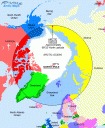 One common definition is the Arctic Circle, the parallel of latitude located at 66.33N. Areas north of this line experience the polar night (a period of 24 sunless hours) and the polar day (a period of 24 sunlight hours) at least once per year.
One common definition is the Arctic Circle, the parallel of latitude located at 66.33N. Areas north of this line experience the polar night (a period of 24 sunless hours) and the polar day (a period of 24 sunlight hours) at least once per year.
(map courtesy of http://athropolis.com)
A second definition is the July isotherm. Areas north of this imaginary line do not experience temperatures greater than 10C (50F) in the warmest month of the year. As you can see, the isotherm definition (the highlighted portion of the map) does not correlate exactly to the Arctic Circle definition.
(map courtesy of http://athropolis.com)
Related to the isotherm is the tree line definition. The tree line roughly correlates to the July isotherm and marks the transition from the forests found in the sub-Arctic to the shrubs and grasses found in the tundra.
(map courtesy of http://athropolis.com)
Another related definition is the extent of permafrost, which is perennially frozen ground. Permafrost only exists in a climate with a mean annual air temperature below 0C (32F).
(map courtesy of Philippe Rekacewicz, UNEP/GRID-Arendal, http://maps.grida.no/go)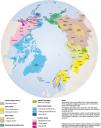
A cultural definition of the Arctic might include the areas inhabited by indigenous Arctic peoples and their traditional hunting grounds. This definition encompasses more area than the Arctic Circle or ecological definitions described above.
(map courtesy of Hugo Ahlenius, UNEP/GRID-Arendal, http://maps.grida.no/go)
Politically, the Arctic includes the territories of the eight Arctic states (United States, Canada, Greenland, Russia, Iceland, Sweden, Norway, and Finland). By other definitions, parts of these territories would be considered sub-Arctic instead of strictly Arctic.
(map courtesy of Hugo Ahlenius, UNEP/GRID-Arendal, http://maps.grida.no/go)
The next time you hear or read about the Arctic, remember that there is more than one boundary. Ask yourself which definition of the region is being used?
Though complex and potentially confusing, defining the Arctic is a prime example of the nature and challenges of classification systems. Students tend to view labels as fixed and static, yet these definitions can be flexible, debatable, and ever-changing.
Posted in Topics: Arctic, Education, International Polar Year, Science, social studies



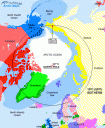
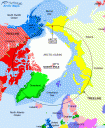
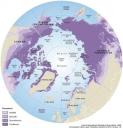
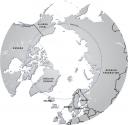
 Follow us on Twitter
Follow us on Twitter


Posted in Topics: International Polar Year, Science, Upcoming Opportunities
No Comments